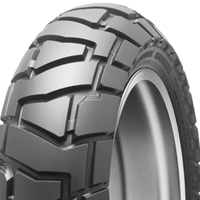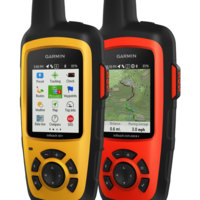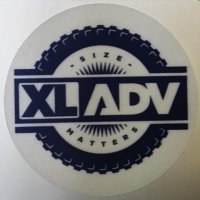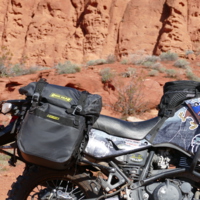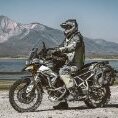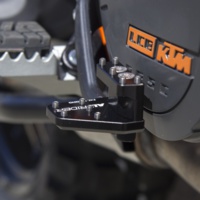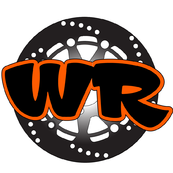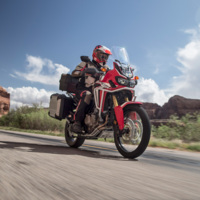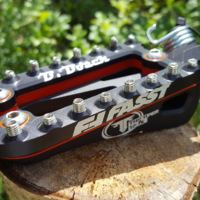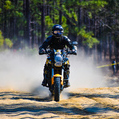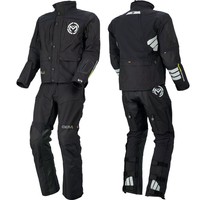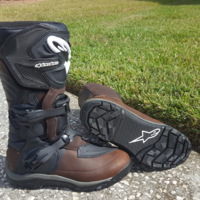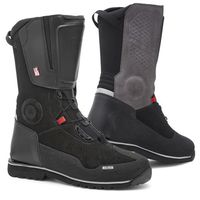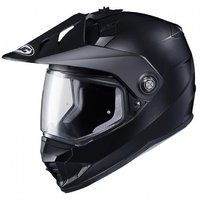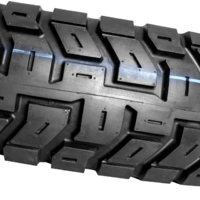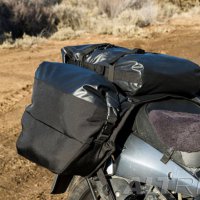Leaderboard
-
in Product Reviews
- All areas
- Events
- Event Comments
- Event Reviews
- Blog Entries
- Blog Comments
- Images
- Image Comments
- Image Reviews
- Albums
- Album Comments
- Album Reviews
- Garage Vehicles
- Garage Vehicle Comments
- Vehicles
- Product Reviews
- Products
- Topics
- Posts
- Articles
- Article Comments
- Article Reviews
- Status Updates
- Status Replies
-
All time
-
All time
December 17 2014 - April 30 2024
-
Year
April 30 2023 - April 30 2024
-
Month
March 30 2024 - April 30 2024
-
Week
April 23 2024 - April 30 2024
-
Today
April 30 2024
- Custom Date
-
All time
Popular Content
Showing content with the highest reputation since 12/17/2014 in Product Reviews
-
I was fortunate to grab an early set of the Dunlop Trailmax Mission Adventure tires in January of 2019 for a 10 day ride from San Diego to Cabo San Lucas (and back) on my 2016 BMW GSA 1200. The trip totaled 2000 miles and was about 20% dirt road with the rest tarmac. I ran the tires at the recommended 36 PSI on dirt, with 42 on the road. The bike was packed with panniers and tail luggage, and I weigh in at 150 lb in a birthday suit. Initial Impression Upon first seeing the tires, I was immediately pleased with the style of the tread pattern. We all want our bikes to look bad-ass and these do just that. I had no challenge finding others to be impressed as well. I heard words like “futuristic,” “Tron” and “meaty.” You get the idea. They struck me as a 70 (street) /30 (dirt) tire, but proved to be more toward 50/50. Street Performance I have ridden several “adventure tires” over the years and these are by FAR the most road worthy and predictable set I’ve had to date. I have a second set of rims that I run street tires on, which is my setup most of the time. Due to this, I’m very aware of what’s lost when I switch to a set of adventure tires, especially 50/50s. The Dunlops, however, were absolutely terrific on the street! At times, I even forgot I wasn’t on my street rubber. They are amazingly quiet and super smooth going in and out of turns. Dirt Performance We didn’t explore much sand or any mud on this ride unfortunately. What dirt roads we did explore proved the Dunlops were worthy however. I felt as sticky as I do on my TKC 80 or MotoZ Tractionator ADVs. The absence of a lot of sand and mud didn’t allow me to push them too hard but I did have several moments in sand, or hairy situations requiring all the bite I could take, and they never let me down. I was shocked at how well they were performing in the dirt after already being impressed on the road. Personally, I think there will be debate over whether this is a 50/50, 60/40, or 70/30 tire, but I don’t have any problem calling them 50/50 so far. Longevity I started the ride with 10mm of rubber on the front, and 12mm in the rear. This may not be the manufacturer’s technical measurement, but those were the readings on my tread gage. What’s important is where they were after 2000 miles using the same gauge. The answer is impressive. The front came in at 9mm and the rear at 10mm! Take the following into comparison. One co-rider was on a pair of TKC 80s on a lighter KTM. I didn’t start measuring those tires until the 500 mile marker where they came in at 9mm front, and 10 mm rear. At the end of 2000 miles, that set measured 8mm front, and 1.5 mm rear! Another rider on Shinko 805s was showing 1mm loss for every 500 miles. As you’ll see from the pics, after 2000 miles the Dunlops hardly look worn. Conclusion If I ran one set of rims, this would be my new tire. No doubt. I love the street feel and they provide a ton of grip in the dirt. I’m still curious to see how they compare to the MotoZ or TKC in the deep sand and mud since I prefer to ride the tire best for these conditions on my dirt rims but one thing is for sure, the Dunlops kill both of these in street performance and longevity. Pics I’ve included pics of the Dunlops and TKC 80s at the 2000 mile marker. The pics with my bike were at 500 miles.5 points
-
I've been a Motoz fan boy since I put the first Tractionator on my 950Adv, but always wanted to try the Dunlop D908 rear tire. However up until the last year or so, the widest 18" they offered was a 140. Personally, not an option for me running 4.5 rear rim. Then the 150 width finally dropped and I spoon'd one on. It went on easy which was surprising considering how stiff the sidewall felt. I did a few short rides just to scrub her in and the first thing I noticed was how quiet this tire is on the tarmac. "Quiet" is certainly a relative term when discussing big blocked knobbies, but the closest comparison I have the the Motoz Desert H/T (which I loved off-road, but was unbearably loud on the hwy to get to said dirt). After about 30 ish miles on twisty pavement, I became very comfortable with the road manners. Nothing unpredictable, and very sure footed. Next test was miles and miles of baby head rocks. Other tires have quickly tossed chunks on this section due to my tendencies to heavy right hand but the D908RR faired very well with no noticeable damage. Racking up about 1000 miles on short trips, now on to the real test, the Colorado BDR. The fully loaded 950 with me on it weighs about 800 lbs. When all said and done, the COBDR provided lots of different terrain, rocks, sand, loose and hard pack dirt, including about 400 miles of twisty pavement (50 of that in a torrential down pour) . The D908RR carried us through without incident and did it very well. The D908RR can be had for about $160 at the time of this review, which is a smokin deal compared to my other "go-to" Motoz RallZ at about $210. Bottom line, I like it, and think I may be a convert. I'll leave you with the attached pic, post COBDR, just shy of 2700 miles total.3 points
-
It drives my wife crazy that I ride by myself…..off road….in the middle of nowhere. I have been looking for something for quite sometime that would allow me to communicate with her, letting her know all is well and what my current location is (I know some people don’t want their wife to know where they are but I do). I have also been in the market for a new GPS setup (the phone stopped cutting it a long time ago). That said, my options were looking like I was going to need two separate units to keep the wife at easy and to tell me where I’m going. At this point I couldn’t even decide which device to buy first.. Then I found out that Garmin (GPS company giant) had bought Delorme (manufacture behind inReach satellite communication systems and software) and had just come out with the inReach Explorer+. I did the math and by the time I had bought a GPS and a tracking/SOS (?) texting device, I could spend the same money and get an all in one. So I went and checked one out at the local outdoor retailer. As I walked out with my new purchase, I was having some buyer's remorse. The Explorer+ IS 450 bucks. “Man…..that’s a lot of jack. But i can always return it” I said to myself….. Upon getting home, I promptly did my best impression of the unboxing therapy guy “ohhh shiny!”. Before you can use your Explorer+, you need to get a subscription. I opted for the “Flex” plan that allows you to stop service at anytime (I don’t do much riding when it gets REALLY cold) and at $14.95 a month…..it’s affordable. You can also sign a 1 year contract and prices for that start at $12.95 a month. I created an account and got everything synced up on the computer and presto….we are off. Like most Garmin GPS units the buttons are very easy to use with gloves on and the color screen is surprisingly detailed and much easier to see at glance than a cell phone. The ease of use was another plus. The real slick part with the Earthmate app (on your phone) is that it can pair with the Explorer+ via bluetooth and use the GPS’ satellite signal without cellular service (or with it). You can also use the app to type out the text messages that would take a little too long with the Explorer+’s buttons. It also shares ride reports, waypoints and routes to your phone. It was a week or so before I was able to do a real world test with it. So, Easter morning, bright and early I headed north into the Cherokee National forest. I was looking for an excuse to say “I really don’t NEED this” but it turns out that I do need it and I am sold. This unit works flawlessly. It sends out “trackpoints” every 10 minutes (which you can increase or decrease in Settings) the check in text I sent to my wife came through and it even showed me trails that I wouldn’t have seen on other maps. They also make a cradle setup that I have since purchased and setup on a Ram mount in my dash area. If I added a large format roll chart I’ll start thinking I’m a Dakar Rally Racer. All in all the Explorer+ is a great unit and I would HIGHLY recommend it to anyone looking for a GPS/inReach all in one unit. Bravo Garmin!! Pros: Easy to use Operating system works excellent Text feature is awesome Cons: It's not cheap Also needs a supscription Bottom line: This unit works so well that I am able to overlook the cons. Fact of the matter is, the price came close to scaring me away. I'm glad I over looked it.3 points
-
2 points
-
Review KLIM Krios Karbon Many of you will remember the KRIOS as the old Uvex helmet shell sold a few years ago. It was a damn great helmet and being manufactured from Carbon fibre made it a light weight affordable alternative to the likes of the more expensive Arai at the time. I acquired my first Uvex around 2008 and used it extensively through Africa, I also had a nasty accident when I went down and my head hit a guard rail at 60mph. Luckily the helmet did the job and I only sustained a heavy concussion. The Doctor at the time told my wife to get the same helmet he had never seen such an impact with such a light head injury. Besides the fact that the old Uvex visor/face shield was excellent and the padding and ventilation in the helmet absolutely first class, what was really important to me was the weight of the helmet. Doing 8 hours a day in heat is no fun if you still must carry a 1.7kg lid on your head. That helmet weighed around 1.2 kg, it doesn’t sound like much but try and carry a kilogram on your head all day long and see how it feels. Weight matters! As well as making for a more comfortable, enjoyable ride. The KRIOS are still under 1.5kg and I think, the only one on the market in that weight category. We really looked after our old Uvex helmets as the newer options were just not appealing to us. We owned the Arai XD, for the price, the visors and face shield was nothing short of shit, they were heavy and just felt expensive for what you got. There were the cheaper options that although complied to DOT/ECE standards did not came over as the type of lid I was willing to trust when hitting the tar. Definitely not prepared to wager my life on a lid that is that cheap! When we saw KLIM had launched the KRIOS and it looked like the UVEX I tried to get information from KLIM as to what the story was behind it. I was really excited at the prospect of owning a helmet that I knew performed well. Essentially, the shape and mould was the same as KLIM had acquired the mould from the company manufacturing for Uvex and another German motorcycle brand. At some stage it was also made for BMW. What was important according to KLIM was that the shell was reinforced and many small new design changes had been made. What they felt was important, was that this helmet was not a brand-new design but had rather evolved over time and most of the design issues were ironed out with the older versions. Essentially, they released a helmet that could offer their customers a proven history but with new and updated research and design added to the current version. We purchased two of them when they were launched, we got ours in Sept 2016 and have had them now for 9 months and 13000km. Out of the box we received two face shields, one dark and one clear and a Pinlock to use for fogging when riding in rain, the helmet also came with a 5-year guarantee. The fittings and finish was a definite improvement over the old and it only weighed a few hundred gram more. The reason for this according to KLIM was that they made the shell thicker and reinforced it. The KRIOS Karbon is a three-in-one helmet concept, street (face shield, no visor), dual-sport/ADV (face shield, visor), or off-road (no face shield, visor, use goggles). Easy to interchange with the simple quick-release fittings that remove the visor and face shield. Just simply lock/unlock with a quarter-turn on the outside of the visor. It is a much easier system than many other brands when wanting to quickly clean the face shield. All the padding and cheek pads are stiff and there are no pressure points. Although the helmet fits snugly and tight it still feels very comfortable and we could ride our 8 hours a day. I understand there are different head shapes, but I am sure this one will fit the majority of people comfortably. There is also a cheek screen to stop wind entering from the front bottom of the helmet which is great when it is cold. I am not sure about all the technical talk, but I can vouch that it works. KLIM - “Klimatek™ Fabric liner systems utilise adaptive smart foam technology and anti-microbial/bacterial fast-wicking textiles.” I sweat a lot and we have been riding from Mexico to Colombia since getting them, and I’m happy to say that in all the heat and humidity they never got that greenish ripe smell. We washed them a couple of times and it is very easy to remove and refit the padding back into the KRIOS. The thing we appreciate most about this helmet is the ventilation. Even in very hot and humid conditions there is always enough airflow through the helmet. Our wind screens on the bikes are quite short and effective sitting in clean air. Head buffeting only became noticeable at very high speeds and was much less than our Arai and other adventure helmets we have owned in the past. I guess it must do with the shape and the large spoiler that goes across the back of the lid as well as the aerodynamic design of the visor. Saying that, wind noise is at acceptable levels. We fitted the Sena S20 and a Sena C10 to the second helmet and it was a quick, easy, hassle free installation. In addition, we use Alpine Hearing Protection ear plugs and we never have to talk loud or scream to be heard over the intercom system. There is enough space with large pockets for the speakers to fit into and not press against the ears. Pinlock is a separate plastic shield insert on the inside of the face shield which alleviates the problem of fogging. We had some issues with the first Pinlock inserts but it turned out the securing pins were adjustable. RTFM - Read the %&#'ing Manual! Correct, I did not, it would have helped if I had. Since then, we have ridden high altitudes in Colombia in cold wet weather and experienced the humidity of the Caribbean, so far, the fogging hasn’t been an issue at all. The KRIOS has excellent venting and is even better than our old helmets. There is a huge amount of airflow through the chin bar vent as well as having a closable top vent. Even with goggles there is still enough airflow. The LEATT neck braces and the KRIOS seemed to be made for each other. I use the STX ROAD and Elsebie uses the GPX5.5, yes, my neck is thicker and more like a log. There is no interference or hindrance between the KRIOS and the LEATT, in fact they allow enough overall free movement. About two weeks ago I had an off on a muddy mountain road in the highlands of Colombia. The combination of the LEATT and KRIOS minimized the whiplash on my head and although I got hammered properly in the ribs, I had no neck injury or stiffness. It is clear that KLIM as with their other products have put in a considerable amount of research and thought into the KRIOS Karbon. Along with their amazing backup, service and quality that they offer with all their motorcycle products this is a seriously good quality item, worth considering when looking into a new adventure/dual sport helmet.2 points
-
Written by Simon Thomas 2RidetheWorld. Product Review: Flexx Bars Manufacturer: Fasst Company A World Of Difference In Your Hands In terms of aftermarket motorcycle accessories, handlebars are probably one of the most overlooked products. We take them for granted. Every bike comes with a set of bars, why should we change them? Good question. Your handlebars do a lot more than simply offer you a place to rest your hands. The bend and sweep of your bars determines how connected you feel with your bike, how the bike turns and even how far back or forward you sit. The stock BMW OEM bars on both the R1200GSA LC and the F800GS are good and suit many riders out there, but based on our riding style and type of terrain we like to ride, Lisa and I knew that we’d need to upgrade them. Over the course of the first 3-4 years of our journey, Lisa and I both suffered from recurring wrist pain, which we finally figured out was due to the angle our wrists were placed when holding the OEM BMW handlebars. Due to the (road biased) sweep (pullback) of the bars, our wrists were slightly kinked outwards. This discomfort exacerbated after days or weeks of off-road riding. The ideal wrist position for us is one that keeps our wrists more neutral in relation to the bars. Think of a straight line passing from your elbow joint, through your forearms, through your wrists and onto the bars. We’d been looking at handlebar options for a few weeks and we were close to going back to our old favourites, either Pro Taper or UK made Renthal’s, when we discovered the Flexx Handlebars. Bolting Down The Bars Neither Lisa or I had heard of them. What initially caught our attention was the varied angles of sweep offered by the manufacturer, the USA based Fasst Company. Cole (Founder) had confirmed that he could easily ship us two sets of bars with our preferred 12 degrees (54mm) of sweep (also called pullback). Lisa’s Flexx Bars bolted straight onto her F800GS and there was plenty of room to fit Lisa’s GPR steering damper without any issues. Securing the bars to my R1200GSA (water-cooled) required the installation of a ROX 1 1/4" to 1 1/8" block riser adapter. This was handy as I was planning on installing a set of risers anyway. Because of the straighter sweep (12 degrees instead of BMW’s stock 19-degree bend) of my Flexx bar set-up, the clearance between my Touratech hand guards and the stock screen was reduced. However, this was easily solved by adding longer screws and nylon spacers, to the screen mounts, which has also improved the airflow over the stock screen. See pic attached. Fasst Company offers the Flexx Bars in five sweeps, three differing heights and four widths, enough to suit the ergonomics of almost any rider.Once tightened down, the Flexx Bars on both bikes look fantastic. Tuneable handlebars The Flexx Bars are tune-able handlebars, and offer a unique design that provides both rebound and dampening options. Yep, you read that right! The Flexx Bars, just like your favourite suspension, are designed to reduce the effects felt from both high-frequency vibrations, whilst minimising the impact of the more brutal hits we’ve all fallen foul of. After my first ride, my initial scepticism was replaced with confidence! READ MORE...If you would like more info and to read the full review then visit our 2RTW review page and get the full run down, specifications and insights into the Flexx Handlebars here: 2RTW Flexx Bar Review Page2 points
-
Nelson Rigg Deluxe Adventure Motorcycle Dry Saddlebags Nelson Rigg 's new "Deluxe Adventure Motorcycle Dry Saddlebags" have proved to be an excellent choice for my offroad adventures. Needless to say I am not easy on any of my gear, especially luggage. I try to spend most of my time off road looking for challenging and sometimes exhausting trails and with that comes the inevitable crash. The Nelson Rigg Deluxe Adventure Motorcycle Dry Saddlebags have been down a dozen or more times and still function as they should. They have been dropped in sand, mud and rough decomposed granite with nothing more than a few scratches and scuff marks, that in my opinion just add character. All of the mounting hardware is aircraft grade aluminum. The cam buckles hold the saddlebags securely to my Tusk Rack and the G-Hooks make securing the bag closed a simple and quick procedure. The webbing straps on the top of the bag are long enough the securely strap down a Dry Roll Bag to the top of it. The internal removable stiffeners keep the saddlebags shape for easy loading and unloading. The saddlebags also include 2 zippered saddlebag liners for easy removal of your contents. The connection to the bike is a simple double wrap of webbing that is inserted into the aluminum cam buckle. From rough roads to whoop sections, this method of attachment holds the saddlebags securely to the bike. Double wrapped webbing to a cam buckle connection. (The wire pull in my hand is part of the Tusk Rack, NOT part of the luggage system) The replaceable pads protect the saddlebags from rubbing and from heat from the exhaust. I am the guy on the ground. This is one of my many crashes with the saddlebags attached. All of my contents were held securely and the bags don't shift while on the roughest trails and whoop sections. I hope that you enjoyed our review! Brandy and Jesse "GeoMoto" Kimball are avid adventure riders and organize the Flying Monkey Adventure Rally every October in Southern Utah.2 points
-
I put this on the 990 last fall and then promptly lost my key and didn't get a chance to really ride the bike off road much until just recently. Not sure why it took me so long to try as I helped AltRider find some riders to test some early versions. @556baller and I rode up a narrow and technical mountain road up to McIver's cabin recently and this is where I really noticed the DualControl brake system shine. We were going up some very steep and tricky roads and then back down. We had to be cautious of two way traffic and had passed a lot of other motorcycles, quads and razors so I was very much in "control" mode. Having that rear brake lever essentially "right there" while on the pegs was of HUGE benefit to me at the time and the light went off. Aha! Yep, I get it now. AltRider didn't necessarily invent this device, as BMW has had it on their GS Adventure bikes and HP2 model for quite some time. I think Jimmy Lewis actually had a hand in the development of that feature while he was a BMW factory rider. I think what AltRider's done here is essentially improve on that feature as well as democratize it to the masses who ride many other types of bikes (BMW, KTM, Husqvarna, Ducati, Yamaha, Honda, Kawasaki, Suzuki, Triumph). The function behind this type of control feature is that stabbing down at your rear brake lever is not only awkward but can double your reaction time and stopping distance. The OEM brake pedal just cannot be in the best position when you're both seated and then standing without this type of DualControl system. So I'm going to say that I think this is a great accessory for anyone who rides a lot of off road conditions with their big bike and are in the standing position a lot. If you're going to be doing skills courses like the GS Trophy or other types then it's a must-have. Likewise, for the rider who does a lot of technical riding. Pro's: Better control in technical riding when standing Increased reaction time, cutting stopping distance Easy to install and comfortable to use Con's Cannot think of a single one honestly2 points
-
I ran these at the 2019 Geico Adventure Rally in Julian (Nov 7-10), and on the road and trails after that for over 7,000 miles total - still had plenty of usable tread, I would guess could make it 8k easy with bite left - These are fantastic tires, homerun Dunlop. The Breakdown... Handling, profile, cornering: I have been a sportbikes & track days rider many, many more years than I have been playing at getting my tires dirty. These tires on my adv have excellent street manners, you can chase down crotch rockets on your way to the trails just fine. They don't have as aggressive a fall-in while cornering as some of the other tires I have run, the front seems to have a gentler profile, just took some slight getting used to and they are fantastic on the road. Noise: None How do they work off-road?: I am just an Average Joe+? ADV rider, I will easily call these tires worthy of 50/50 title, all day, take it or leave it. I rode out to Font's Point and back which was relatively sandy the entire way with no "line" to speak of, and as long as I kept giving gas, I didn't fall on my ass, no herky-jerky feedback in the sand from the front, just pushed right through. Did Boulder Creek to the falls or whatever it's called and up to Eagle Peak, and that fap-worthy hard flat high speed dirt after that.... on the fast routes you can just riiiiiiiiiiiip, for the more technical black diamond bits, I never felt like the tires let me down. All the other blue routes we ran that had good-good dirt I think my buddies I was riding with would agree I was having a blast ripping around on these tires, the rear has such a consistent and predictable spin when grabbing throttle that you can probably get too comfortable going faster than you should be on a not knobby tire off-road. That being said I never felt like the rear or front were going to danger-level step out on me. Tire wear: At 700 miles, can't tell if any tread-depth has been used at all... the fuzzys are gone though. The edges of the treads are rounded off slightly from sand, and wheel spin in dirt, but I think after I street these back and forth to work for a few weeks they will be sharpened back up. The tread didn't tear, or chunk out at all during the rally despite being used.Sidewalls: The tread extends down the sidewall I am not an expert dirt or sand rider at all, but the tires did well in the sand I was in at my average level of sand things, I did feel more confident than I have in times past... Not sure if that's just a good day, or maybe these tires are doing something right with the extra grabby thingies on the sides. For you air-down types, these might be a good tire... seems like at least the rear has a much stiffer sidewall than I'm used to. Do they wobble in rain grooves: Nope, NOT ONE BIT... YAAY!... Not while cornering well north of 80 on grooves either. Do they look rad: Yes, I also rode them to the local dealership and you might say they brought all the boys to the yard. Speed test: If I was a betting man, I would bet that if someone had tested them in this manner... these tires are just fine above 3 digits. Balancing: I use a static balancer, these took a lot less time and weight to balance than big blocks, probably just luck but the rear needed zero weight. In summary, they did really well at the Rally, and continue to be great daily commute and weekend trail warrior tires at the same time. We hit easy, medium, and black diamond at the rally and I was never anywhere thinking to myself "F these tires", instead I was continually surprised at what I was getting away with that they were just doing the things that needed doing for being 50/50 - after 7,000+ miles they never lost their bite, and still had plenty of tread depth left. Eric just put them on for the next part of his SA trip... lol they might take him damn close to the end. In summary I will say these are absolutely the best 50:50 tire out there, and every bit deserving of that designation. They are NOT knobbies, they will NOT perform like full knobs, but if you want a tire you can comfortable cruise freeway speeds on all day, and then get away with a lot more than you might think off road all weekend... all while having ridiculous high mileage... then give these a shot. TIREPORN: Fresh set: Mounted on the 800: Rear tire tread shot: The Front tire tread: Balanced easily: End of the 2019 GEICO ADV Rally in Julian: Rear tire with over 7,000 miles on it:1 point
-
I’m a tire snob and a tire whore.. let’s start there.. 2nd, I have a tendency to ride faster than one probably should on a loaded out ADV bike, especially on the street. I am not throttle conscious as it pertains to “save the tires”, I subscribe to the “fun meter” way of thinking and the meter is generally set on 11.. I am a tire ruin’er put simply.. TKC 80’s lasted less than 1000 miles on my bike on the AZ BDR, Kenda Big Blocks 1200mi in and around Death Valley, Pirelli MT 90’s 3400mi on a pavement assault of Northern and Central California, Motoz Adventures I can typically get 1800-2000 miles out of.. 3rd disclaimer.. I received a set of Dunlop’s new Trailmax Mission tires at no cost to test and review thanks to Eric Hall, XLADV and Dunlop.. that said I have zero obligation to report anything here on these tires but reality.. So.. on to the tires.. I am 2000 miles in this far.. just got home from their first trip. 7 days in Wyoming, Montana and Idaho. 90% scenic backwoods pavement carving, 10% mountain fire roads putting up dust. Think, Teton pass, yellowstone, beartooth pass, dead indian pass, going to the sun road, lolo pass, bitterroot valley.. etc etc.. My setup was this for record. 2016 Africa Twin CRF1000L. Leo Vince full system and DynoJet Power Vision 3 Remapped ECU. The bike makes a bit more hp & tq than stock. Total weight with rider comes in right at 900lbs.. bike weighs 550lbs wet, luggage and accessories come in at 110lbs, I weigh 210 and wear 30lbs of gear.. pressures set at 38lb rear, 30lbs front. So.. to recap Dunlop Trailmax Mission tires. 2000mi of scenic twisties, open hwy and fire roads, 900lb bike with rider, 100hp on tap, giving it the goat... Install. Tires feel a bit heavier duty in the carcass than all other 50/50 tires I’ve ran. Carcass is more Motoz ADV than Pirelli MT90. Rear was a challenging install even with a tire stand, proper tools and copious lube, uber stiff bead and sidewall. Proof I believe this tire is built to last. The front was a typical 21" install most could do blindfolded. Front and rear both balanced with just 1/4oz. of weight with the lite spot dot aligned with the valve stem. The least I have ever seen, further proof of a superior manufacturing process and product result. Looks wise I think they look smashing on the bike.. First impression. My first miles on these tires was a pre-trip shakedown run out of Vegas to the Hoover dam and back. I noted two important details.. #1 this is the first tire I’ve spooned on my Africa Twin that induces zero head shake oscillation at 90+mph.. anyone that rides an Africa Twin at the upper nend of the speed spectrum knows what I’m talking about. This tire is planted.. period, right up through 120mph where the Africa Twin says enough already. #2 noise.. or lack thereof. Asphalt, seal coat, smooth concrete, grooved concrete, none produced any detectable road noise. Turn in is predictable and linear. They feel slightly heavier than Pirelli MT90’s in rotating mass but that’s a just barely feel and not a hindrance in my opinion. They have a lighter feel in motion than Motoz ADV's. Off to see the wizard. We trailered to Idaho Falls from Vegas, as our launch point for the ride North. Days 1-3 were all high speed mountain passes and backroads through Jackson Hole, The Tetons, Yellowstone and Cody, Wyoming. We did a bit of dirt two track to camp on night 1 that included a steep and totally blown out hill climb that was about a mile in length. There were rocks, dust silt, holes, gravel and hard pan. This was my first foray with the Trailmax Mission’s off road. I was very very pleased in their performance.. I found them to be lacking nothing. Forward drive was great, the front provided ample feel and the rear broke loose on command when desired but remained highly controllable with throttle input. I was able to step out the rear on the exit of dirt corners predictably, the rear did not show signs of high side danger from power slide slide lateral hookup when pushed, even when throttle was chopped mid-drift. Pavement manners were absolutely brilliant.. I pushed and pushed and pushed these tires on the road. Loading the front tire hard mid apex at speed by chopping the throttle, upsetting the chassis at lean angle, the front never seemed to care in the least. they were as reliable as a tires could be. 100hp and 75lb ft of tq isn’t a lot but with traction control off, its enough to spin up a rear on the pavement once a tire is heat soaked and pushed with irresponsible corner throttle control in the case of most tires. Especially when you are transferring the weight of 900lbs through the corners. I tried diligently on multiple road surfaces to break the rear out of corners. Simulating even the most panicked mid corner squid moves I could muster. I was never able to break the rear on any non dirt road surface, they seemed totally un-fowl able. Wear. One issue I’ve always found to be true with tires on my ADV bike is that they don’t go the distance. I am generally a rear tire per trip guy and front tire per 2 trips. Heavily loaded and flogged adv bikes are really hard to keep tires under. Guys that claim to get 5-6k miles out of tires I wonder if they are even having any fun? These tires showed very little signs of wear 1000 miles in, despite my attempts to bludgeon and beat them mercilessly. Dirt. On this 2000 mile trip we road approx 200 miles of dirt. Each section was a mountain pass two track road of hard pan, gravel, river crossings, open faced imbedded rock and dusty dirt highways. I pushed and pushed and pushed these tires. The rear I found to be incredible in its performance off road, despite its non-aggressive appearance. It performs off road as good as many much more aggressive looking tires I have flogged. The front was near equally impressive, I was able to find its limits off road only after trying to purposely find it. There were just two instances I was able to break the front loose off road. The first was on old backroad ranchy two track, my line to keep was filled with a mixture of sand and dust silt ahead a top hard pan. Loose sand and silt is always a difficult proposition on big bikes, this was no different. Maintain speed, add throttle when you hit it and power through.. the front hunted for center, wallowing a bit lefft and right. The second incidence of this was again on hard pan with heavy dust silt atop the hard pan.. aka dirt road black ice. Mid corner throttle chop loading the front tire I was able to tuck the front, it would immediately re-track and regain traction once throttle was re-applied and weight was rebalanced on the chassis. The second instance was only replicatable through sheer squid moves mid corner, in an attempt to find the limit. Would a more aggressive front have done the same? From my experience a more aggressive front such as a tkc80, Kenda Big Block, or Motoz dirt variant would have held out a little longer before letting go in this situation offroad, but probably not much longer. Personally those little tucks of the front when ham fisted in tough conditions off road I am more than happy to accept, in exchange for all of the other times and places these tires outshine the competition in the 50/50 tire segment. 2000 miles in I couldn’t be happier with their performance. Their wear is barely showing and the wear that is occurring is very linear across the tread on both front and rear. This weekend I will put another 1000 miles on them in the Sierra’s at High Sierra Rally. I will continue to report back on their performance until they are toast. 2000 miles in I give them 4.5 stars. They are to date the best well rounded do it all tires I’ve ran on a big bike. I have a feeling that opinion isn’t going to change. But we shall find out. Some video while testing.1 point
-
I've had experience with two pairs of the Rade Garage pegs on different bikes. Anyone that know me knows I can be a bit hard on the ol' 950 (yes, I crash a lot) and these pegs have met the challange. The grip wet or dry is excellent. The size of these pegs is the perfect middle ground between standing comfort and terrain clearance. Can you get bigger pegs that offer more support when standing? Yes, of course but then you run a greater risk of catching them on rocks, cactus, brush, slower dudes on other bikes, etc.... The 15mm drop may not sound like much, but it does wonders for opening up the cockpit for taller riders. Shipping from Rade is acceptable in terms of cost and timeline.1 point
-
1 point
-
photo credit - Justin Coffey WestX1000 I cannot tell you how honored I am that Honda US chose us to review their 2017 Africa Twin with DCT. You the forum member have made this a grass roots big bike community and bike manufacturers are starting to take notice! They want us taking a good hard look at what they have to offer not simply because of who we are but who we are not. We are not the paid magazine industry who dares not bite the hand that feeds them lest they be cut from the next model launch their income is so dependent on. We have some serious “dirt cred!” Honda is a legendary motorcycle maker with a very long history of quality, dependability and most importantly race victories. The original Africa Twin has FOUR Dakar wins to its credit and this new machine is light years beyond the original. Makes one wonder what the possibilities would be if there was a new big bike class at the Dakar (as they have at the Baja Rally we’re racing Oct 9-15)? So what is the big deal with the 2017 you may ask? CycleNews had the Africa Twin besting the KTM 1190R last year but even just this past Aug they compared it to the impressive 1090R and it still won! So how is it? In a word: fantastic. I’m really just blown away at everything the bike has to offer from it’s zen-like design & balance to its power & control to even its stunning graphics. Is it not already obvious Honda has a winner on its hands? This bike will sell many units from now until years to come, no doubt. Pavement This bike is such a dream to ride, especially with the DCT (most appreciated in stop & go traffic), that it immediately had me realizing this bike is a GS-killer. Sure it’s “just” 94 hp (or is it?) but it doesn’t lack for power at all and handles so incredibly well (even with its 21/18” wheel setup) that combined with the value (~$13,700) and dirt-ability has me scratching my head why anyone (who likes to ride beyond Starbucks) would ever buy another GS. The bike was a pleasure riding the highway about 700 miles to and from our High Sierra event and passing cars was a cinch with the DCT quickly downshifting and catapulting my 235 lb frame with ease. I’ve read that riders above the 6’ mark will suffer buffeting on their heads but at 6’3” this wasn’t noticeable. Range is roughly 200 miles with its 5.0 gallon tank & mileage in the 40’s (even with a heavy throttle). The reserve light came on at 178 miles. Cornering was a bit mushy but tightening the suspension is all that was needed. photo credit - Spencer Hill @the_gear_dude Dirt Worth noting that I typically ride mostly dirt and the tougher the better so I’m not really representative of the typical adventure motorcycle rider. There are a few advantages to riding with DCT off road such as paddle shifting (my favorite!), shifting in corners and letting the bike clutch itself giving you essentially near perfect traction so you can concentrate on your line. However, there were a few things I did have to give up such as the ability to loft the front wheel, locking then spinning the rear wheel in corners, starting in deep sand in second gear and the inability to engage gearing when in a rolling start (have to stop first, then engage). While at our High Sierra event, I chose to ride in manual mode and once I stiffened the suspension I had fallen in love with this machine! We do some pretty gnarly tracks at High Sierra and in the OHV area between Mammoth and June Lake there was literally not a single thing that held me up. We did end up turning around on a long sandy incline but guess who made it the furthest? I aired down the Motoz Tractionator Adventures a bit more and found the Africa Twin just laughs at deep sand. A riding partner’s 1190R fared the worse in these conditions. While at the Sierra ADV Rally I chose to ride dirt in DCT full auto mode and learned quite a bit about its development from the one and only Johnny Campbell who was there filming a video on that very topic where he rode both to demonstrate the benefits of DCT off road. While the Africa Twin, unlike other bikes, does let you change settings very easily on the fly, what it doesn’t do is save these settings when you turn the bike off (leaving the key on); something that happens quite a lot in group rides. Each time I resumed my off road ride there were four buttons I had to push: traction control (off), gravel mode, engage gearing then switch to manual. I got really good at it though and it doesn’t take but 5 seconds once you’re used to it. I was a bit surprised I didn’t need risers either. I did not find that I was hunched over the bars or felt I was going to fall over the front of the bike. I would probably go with a 1” riser given I’m so tall but it wasn’t glaringly absent as I’ve felt on other bikes. The pegs could be larger but didn’t bother me as much as I thought they would (removed rubber inserts for off road). What makes this bike so great off road is probably its low center of gravity thanks to its parallel twin engine & patented air box. photo credit - @Spencer Hill @the_gear_dude DCT The DCT (dual clutch transmission) is seriously something to behold. I’m not an engineer and I’m sure I haven’t even scratched the surface of everything it does but it’s obvious to me this is a huge technological advance and will grow in the future. I see it as the future of riding both on and off road. It just takes so many things out and lets the rider concentrate on enjoying the scenery & focussing on their line. The average rider is not competing in an enduro event and will appreciate these features even more than I do. I can see the world traveler too… all loaded down and riding down a slippery muddy road in the middle of nowhere eager to get to the next town being able to simply pick a line and let the bike do most of the work for them. Manual transmissions in cars used to be much more popular too but few of us really miss all that clutching and shifting. Who knows… what with such an easy introduction to off road, I wonder how well the Africa Twin could introduce an entire new segment of rider to the dirt? That would be a good thing! I thought the more avid off roader like me would probably prefer the manual option but now I'm not so sure. DCT does add about $1000 and 22 lbs too but I found I was the first one up every difficult hill and other riders better than I were left struggling for what I attribute the AT's DCT basically auto clutching for me. Some say the DCT is always a step behind and can't see the road ahead but that's why the paddle shifters are less than an inch from your left hand; just change them yourself. This video Johnny Campbell has coming out on the benefits should be very instructive (will insert here when it's released). We chatted for about 20 minutes about what it does well and his involvement in its development. Here's Johnny! - photo credit: Miguel Santana @masfotografia I won’t liken DCT to this beer-pouring machine I found in Tokyo but there is a certain cultural fascination with engineering and automation you have to visit Japan to appreciate. But is it better than my 990? Apples. Oranges. My 990R is heavily modified with aftermarket suspension (Konflict), wheels (Woody’s), performance parts (Rottweiler), auto clutch (Rekluse) and is lighter than stock. I did once ride Ed Luke’s 990 (standard) with bone stock suspension and can say the Africa Twin is certainly better than that but am not sure if both were modified that I’d still say the Africa Twin is better (off road at least). I will say the Africa Twin is better on pavement and more comfortable to ride. For the average rider I’m sure that counts for quite a bit. Bottom Line I would buy an Africa Twin and feel very good about it. I admit I was skeptical that any Japanese XLADV bike would be this good both on and off road. You just can’t deny the design, functionality, performance, quality, etc… I’d go with a set of full bars and skid plate (AltRider), some wider foot pegs and soft bags (Wolfman Luggage) and maybe stiffer front fork springs and a re-valved suspension (Konflict) and more stout hand guards and that’s it. I would love to get the chance to try a 1090R similarly and tell you all about it given my orange history and preference for the dirt but for now I’ll just have to take CycleNews’s word for it. In their words: “The KTM is what you ride in the Roof of Africa extreme enduro. The Honda is what you ride to the Roof of Africa to spectate, then around Africa, up into the Middle East, to Europe, and eventually on the boat back to the U.S—an adventure we can all do.” Likes: Plenty of power! DCT is a dream on the pavement & especially in stop & go traffic Hill climbs with near perfect traction/slip Really tight turning radius helps in slow speed maneuvers & contributes to balance Bar height even sufficient for my 6’3” height! Handles remarkably well off road for its weight (534 lbs) Fuel economy in the 40s & a heavy throttle yields about a 200 mile range Dislikes: Can’t loft the front wheel Can’t lock the rear then spin it (cornering) Can’t start in 2nd gear (deep sand) Rolling start can’t get in gear without stopping first When stopped and turned off (key still on), still have four buttons to push to get back to where I was: traction control, gravel, put in gear then switch back to manual. Other bikes won’t do that as long as the key is still on. The tank does throw off some heat requiring you to back off in summer temps but I can see this as a feature in colder temps; basically a groin heater but not "surface of the sun" like the KTM Suspension is soft but when tightened up performs even better than most stock adv bikes1 point
-
Shout out to Lee Block and Racer Gloves USA. I bought a set of the "Mickey Gloves" at the June Touratech Rally, for dual sport riding. I chose that model because it had armor on the palm and knuckles, and because it cinched around the wrist firmly so the glove wouldn't creep on the grips. The glove is designed with a natural curl so it fits the grips and doesn't bunch up on the palm. As far as fit goes, I have fat hands, but short fingers. I chose the Medium size because the fingers were shorter, even though slipping them over my fist was a bit tight at first but they loosened up after a few hours. I found I could easily operate the touch screen on my Garmin Monterra wearing these gloves, but for icons that were very small I had to remove them to make a screen command. An application of screen juice on the tips of the fingers will solve that problem. I wore these gloves on a recent ID BDR trip. At the end of the journey my hands were blister-free. Usually on a long ride I get blisters and calluses, but not with these gloves. I also wore them on some hard trail rides on the KTM, busting thru the branches with my knuckles. They worked as advertised - that armor works! They exceeded my expectations. I don't like spending $117 for a pair of gloves, but these were worth every penny, and more. Much more.1 point
-
When I get a new bikes, there is always some tweaking necessary to make it home. A number of years ago I started riding on over-sized foot pegs, I've grown to love them, so it's one of the first things I swap out. Recently, I picked up a 2017 KTM 690 Enduro R and while the stock foot pegs offered plenty of grip, they just felt tiny. I jumped on the interwebz to see what options were out there and I came across a picture of the Fasst Company Impact Adventure Foot Pegs. They looked awesome and I'll admit, the splash of KTM Orange caught my eye. KTM guys... The unique feature of the Impact Adventure Foot Peg is that its bolt-on foot bed is completely isolated from its base by an elastomer. The idea is to reduce vibration and harshness from being transmitted to the rider. Not that I specifically set out to find something like this, but the approach made sense, the rest of the foot peg met my needs, so I figured there was no down-side to trying it. Fasst Company Impact Foot Peg elastomers come in 6 Flavors. Installation A couple of minutes per side with basic hand tools. Happy to report that the included springs aren't overly stiff like others I've installed that can make it way harder than it needs to be. The new cotter pins are longer than needed for the 690 Enduro R, but a pair of dykes fixed em' right up. Performance I'm going to jump right into talking about how they dampen vibration & shock because I think that's what most really want to know. At first, I thought about how I'd measure vibration vs. the stock foot pegs, but after some reading and talking with the Fasst Company guys, doing so was far outside my capabilities and budget. So, butt dyno it is! But, isn't that how the rest of you are going to judge them? Versus the ultra smooth 800cc in-line triple of my last bike, the 690 Enduro R's big single has a lot more vibration. Nothing to whine about on the trails or on 45 mph back-roads, but with fairly aggressive DOT knobbies, as the speed picks up, so do the vibes. While you still feel stuff through the foot pegs, the repeating, high-frequency vibration patterns of the engine are just about gone. My riding partner is on the 2017 Husqvarna 701 Enduro that not only has less aggressive DOT knobbies (TKC80s), the 701 has an all new mill with a 2nd counterbalancer. We traded bikes half way through the day and despite his smoother bike, he said that the Impact Adventure Foot Pegs on my 690 definitely felt smoother. So, for the slabbin' we do to get to the trails or connecting trails on higher speed hard-packed dirt roads with lots of square edged bumps & washboard, the reduced vibes is appreciated, even if the feeling isn't overwhelming. But, you have to think cumulatively. Less vibes and shock over the course of a full day or a multi-day riding trip adds up to more comfort and less micro trauma. The later might not matter to the younguns', but as you age, it becomes more valuable. Since the off-road terrain I ride in central Florida is overwhelmingly soft sand and you couldn't find a rock if your life depended upon it, I'm not sure that I've really put the product through its full paces when it comes to shock reduction. However, I'll be up in NE Tennessee over the summer where I'll encounter plenty of embedded rock with squared edged hits. I'll report back then, so check back if you're interested. In terms of feel, control, and grip, the Fasst Company Impact Adventure Foot Pegs are great. The generous 4 3/4" X 2 3/8" foot bed means there is always a comfortable position to be had and it gives you extra leverage that is valuable when riding a heavier bike. Boot grip has been perfect, but to be fair, we don't have greasy mud where I ride, so your mileage may vary. Access to foot control was unaffected from stock, something I didn't have issue with anyway. Bryan's Bottom-line I really like my Fasst Company Impact Adventure Foot Pegs. Vibration & shock absorbing tech aside, they are competitively priced in the category and do everything that you've expect from a premium over-sized foot peg. Add the vibration & shock absorbing tech back into the equation and you have a winning combination. Not that I'd buy the product purely for the elastomers, but they are absolutely an added bonus to an already solid foot peg. Check em' out @ https://www.fasstco.com/collections/motorcycle/products/impact-adventure-peg As an aging rider, I'll now never not know what bike is mine. Thx Fasst Company!1 point
-
Only change I'd make to these fantastic boots is more water resistance. However, mine are 3 years old and have been beaten hard, so this likely figures into their lack of water resistance. I've even had mine re-soled after my pegs finally wore through the outer sole and I chopped a notch in the right instep from kick-starting my dirtbike and hitting the peg a few thousand times. The buckles are a better design than I've seen on a lot of boots, and I've failed to break them despite trying. Steel toe-caps prevent the sole falling apart and deflect rocks. Read the commercial reviews to understand how the boots prevent torsion and getting your toes sucked back under when you accidentally catch a rock. If you're the type to ride with hard panniers anywhere but asphalt (which I highly discourage), boots like the SG12 will greatly increase your odds of avoiding a tib/fib fracture if your leg gets pulled back when you dab in harsh terrain or when surprised. Do yourself a favor and don't fall victim to the "adventure boot" hype and get comfy walkers. If they're comfortable for walking, they're garbage for serious protection. Besides, the idea is to ride, not walk, right? They're a bit bulky and boxy, and I've heard people on some bikes have to move their shifter up a tooth sometimes. I've not noticed this on anything I ride. After 3 years of extensive use, often in winter in Washington where we're under water half the time, the inner liner at the heel area is starting to fall apart. I still love my boots though and will milk them for another season. My riding style is extremely aggressive (reckless?), including small bike enduro and hare scramble, as well as big-bike shenanigans and racing on the 950SE. These boots have saved my toes and ankles dozens of times, more than offsetting the significant price tag. I'll buy Gaerne SG12s again. The only other boot I'd even consider is the Sidi Crossfire 2.1 point
-
I've been wearing the Krios for a month straight and have to this helmet is the real deal for adventure riding. The main draw to this helmet is the incredibly light weight at just under 3lbs which is noticeable both in your hands and on your head. It is lighter than any of my helmets, including my dirt lid (Fox Pilot V2), and feels like nothing when you wear it. I was surprised to find that the helmet's interior is of Arai level quality and plushness, and although a bit snug at first, broke in quickly with no hotspots. The fit is more towards an oval shape - more oval than my Shoei RF1200 but not as oval as some Icon lids I've tried. I am a medium in every helmet I've owned but I had to go with a small as the Krios sizing runs large. It is Sena compatible and was easy to fit a 10S unit. The Krios comes with two pinlock ready shields - a clear and smoked - and one pinlock insert. Changing shields and helmet configurations is easy and both the peak and shield are held on by the same 1/4 turn latches. Be careful that you have everything lined up correctly and the latches completely seated and closed; if you don't have it seated correctly flipping the visor up could turn and pop the latch out ( I had this happen twice). I used the pinlock on my clear visor and it works excellent. My tinted visor (without pinlock) fogs easily with a little heavy breathing, but also clears the fog away very quickly. The visor fits over goggles although you do have to make sure your goggle strap is position correctly to allow the visor to close over it. One annoyance is that with the visor in its furthest raised position it is still within your field of view more than I'd prefer. Fortunately it is easy to completely remove the shield and run goggle only, although I would prefer a slightly bigger eye port to allow for more google positioning adjustment. On the highway the helmet is stable and the peak doesn't cause much drag, even as speeds touch triple digits. I've found it perfectly suitable for the several hour long stints of highway I've found myself on and was pleasantly surprised by how quiet the helmet is, even when I'm wearing goggles with the shield up. The helmet vents fine for adventure riding but is not enough when it comes to riding tight single track and slow, technical trails. The helmet has only two intake vents, one at the chin and one at the brow, with only the brow vent being closeable. Most confusing is that the vent on the snout seems to only vent to the cheek exhaust vent, as the interior of the snout is covered with EPS foam. I understand that they want to channel the air but the exhaust vent is very far forward to the point that is at the front of your cheek pads. The chin curtain is a nice touch but it is not removable and only adds to the ventilation issue. In short, this is nearly a perfect adventure helmet but don't expect it to replace your dirt lid for real off-roading and aggressive dual sport riding.1 point
-
Moose Racing ADV1 Jacket and Pants - http://www.mooseracing.com OVERVIEW It has been a blessing to have had the opportunity to test and abuse many different brands of riding gear over the years. Moose Racing has always developed quality products, so there was little chance I would be disappointed when I decided to spend a year putting their flagship “Adventure” setup to the test. The ADV1 jacket and pant tops their lineup, designed for the serious Touring / Adventure enthusiast. As you would expect, they come with a loaded spec sheet (though we've all seen overblown marketing of products that don't live up to the hype). So, as I do with every product I review: 1. Start with an open mind and 2. Have a plan of attack. Open mind, check! Plan of attack, check! To kick-off this year-long review I would be meeting-up with my best friend Bryan Bosch for a 12-hour adventure ride in the Pacific Northwest (see the full XL-ADV Ride Report), then spending fall and winter in the rain and snow of the Colorado Rockies, and finally wrapping-up in the spring and summer in the heat of Florida...a true multi-season, multi-region test of the Moose gear! FIRST IMPRESSION Moose has never let me down over the years, and the first impression of the ADV1 gear would be no different. Unpacking the box, I could just feel the “substantial” weight of the materials and integrated protection…this gear is HEAVY (XX lbs.)…but this is exactly what you want from gear that is going to protect you from bouncing down a gravel road or freeway. FITMENT I’m a big-boy…5’9 and 280lbs…yeah, I said big! One of the challenges I typically have when looking for gear is finding gear that will fit comfortably. I pleasantly surprised to see that the ADV1 jacket comes in sizes up to 4X and pant up to 48” waist. So, I followed the recommendation of the manufacturer on sizing, then (just to be safe) I bumped both up to the next larger size…perfect fit for my unique shape, so for anyone else, just stick with the Moose sizing chart and it will be spot-on. Then something amazing happened…this year was the year that started to get serious about some lifestyle changes, and as a result I lost 45 pounds, which is great, right? Not if you have a set of *AMAZING* riding gear that I’ll now be swimming in! Thankfully, the ADV1 pant has zip-off bib with suspenders and though I have way more room than need be, once on my bike I don’t even notice…thank you Moose! OVERALL PERFORMANCE This is one area where testing gets personal. No one wants to crash, and it usually sneaks-up on you and takes you by surprise. This week, that’s exactly what happened to me. Bryan and I were out on our new bikes (Bryan on his 2017 KTM 690 Enduro R and me on my 2017 Husqvarna 701 Enduro...check out the #DualSportDuo BLOG over on ThumperTalk), creeping up on 200 miles on the ODO, and then it happened. On a (very) hard-packed dirt road in a neighborhood under construction, I grabbed a handful of throttle and 74hp sent me on a long low-side, dragging my left knee on the ground for most of the crash. I hopped-up quick as to not allow Bryan time to capture the aftermath on his cell phone, then did the injury assessment. The ADV1 pant took the brunt of the impact, and due to the integrated D3O EVO Pro XT knee protectors and D3O EVO Pro XT hip protectors, I walked away completely unscathed...yes, the integrated protection works as advertised. Thank you (again) Moose! Now for the Florida heat...the jacket and pants are loaded with vertical vents that *actually* work! Just got home from a dualsport day trip in 85 degree heat with 65% humidity...yeah, it was hot and sticky when stopped, but anytime we were moving I didn't notice anything but the airflow through my gear. WHO ARE THEY DESIGNED FOR? The ADV1 jacket and pant takes all the best features from their entire gear lineup in creating their top-offering in the Touring / Adventure category. Top quality materials, lots of protection, flexible, waterproof...and not just on paper, but fully verifiable. How do I know? Because this year I’ve not only used this gear for riding, but this winter I put it to the ultimate test…snowboarding in the Colorado Rockies! Yes, you read it right…I used my adventure riding gear as snowboard gear. How did it perform? As you would expect any Moose product to perform…AMAZING! I was warm and dry all day, though I spent a lot of time sitting on my butt in the snow, and at one point I spent 45 minutes hunkering-down in the backcountry waiting for blizzard / whiteout to pass through. My Moose gear kept me warm and dry through a very scary situation. PROS Looks great Built-in protection that really works Venting that actually keeps you cool Waterproof zippers throughout Configurable (suspenders, gators, sleeves, liners, etc.) CONS Expensive (but worth every penny!) Heavy (due to built-in protection...but it's removable) SUMMARY I love this gear! I can't say enough about any one area because the ADV1 jacket and pant have continued to exceed all my expectations. I have now logged many hundreds of miles in varying weather conditions, hot, cold, wet, dry, and multiple crashes...the gear has stood up to everything I have thrown at them. All-in-all, Moose makes a great product and I would recommend them to anyone looking for great adventure gear!1 point
-
The Alpinestars Corozal Adventure Drystar Boot was designed for adventure and light to moderate duty dual sport riders who want a good quality boot, but are willing to give up some features for a more affordable price. I’ve ridden in a few other boots in this segment and at its sub $300 USD price, I think that the Corozal has put a few brands on notice. In contrast to Alpinestars MX boots, the Corozal is pretty toned down in terms of colors. It comes in all black, but I chose the oiled brown suede leather with black TPU shift pad & shin plate. It has an old school look that appeals to me and apparently others when I shared a pic on Instaglam. One design feature that stands out is that the Corozal only has two buckles. But, after many miles of use, both with & without in-the-boot knee protection, I can’t say that I noticed any downsides vs. boots with as many as 2x the buckles. They most certainly go on & come off quickly. In conjunction with an upper shin plate enclosure has a pretty generous patch of strong Velcro, the boots feel secure on your feet. Since we’re talking about buckles, the Corozal doesn’t get the aluminum units found on their upper-tier Toucan Gore-Tex Boot, but they function well nonetheless. Adjustment is the typical serrated back push in/pull out buckle straps with an arrowhead tip that easily threads through the buckle latch, closing securely with a "snap". When closed, the instep buckle does stick out a bit. There is a molded TPU ramp to deflect latch snags, but the buckle strap has an outward arc to it. While I didn’t manage to get trail brush jammed under it, it’s entirely possible. When I first slid the boots on, I thought that they were going to be too tight. They go on snugly. In hindsight, I felt this way because my current ADV/dual sport boots are on the loosie-goosie side by comparison. The Corozal are more form fitting and no matter how many hours I had them on, they were comfy. My rule of thumb is that if I notice something while I’m riding, it’s probably not that comfy and these boots were very much put on and forget about em’. Lastly, no break-in was required; they felt good right out of the box. Sizing appears to be true, the max circumference of the opening is 18”, and each boot weighs in at slightly over 3lbs.. The Corozal features a molded vulcanized sole that offers good foot peg traction and support in rougher conditions, but unfortunately the instep section is not replaceable for wear. Alpinestars did a good job balancing sole rigidity with walkability. Buyers in this segment do some walking when exploring and you can do so in the Corozal without looking like a robot. Not sure I'd do a 5 mile hike in them, but I have a bike. Why would I want to!? Also aiding walkability and operation of foot controls is what Alpinestars calls “Bio-mechanical lateral “flexi-blade” system”. More simply, it’s a semi-hinged system that allows for fore & aft movement at the ankle while maintaining proper support and protection. I had no issue with movements necessary for accurate shifts or rear brake modulation, but after a few rides, the hinge developed a squeak when walking. On Instaglam, others reported the same issue and when I mentioned this to the Alpinestars folks, they suggested a couple squirts of Silicone spray. This worked like a charm. In terms of protection, above I stated that I thought the boot was good for up to moderate dual sport use. Surely there are more protective off-road boots in the Alpinestars line-up and in the market in general, but for the audience the boot was designed for, I think the Corozal has the key areas covered. The toe box is hardened, steel shank, reinforced ankle, and TPU shin plate. The only area that I’d like see more protection built into is at the back of the calf. It does have foam padding that will absorb some hits, but I’d like to see some strategically placed TPU here. But I have to remind myself, sub $300 price tag… going to have to give on something. Lastly, Alpinestars doesn't specifically lists the Corozal’s Drystar membrane layer as waterproof, but “proven performance in difficult weather conditions.” Unfortunately, since I started riding with them in December, central FL has had very little rain. Probably the driest winter I recall. So, none of the riding conditions really tested this. However, I hosed them down pretty good with a garden hose for a couple of minutes and didn't notice any water intrusion. So, at the very least, I’d call them highly water resistant. I’ll need a wet FL summer to test waterproofness. I’ll report back. Overall, I like the Alpinestars Corozal Drystar Boot. They appear to be well made, comfortable, don’t hinder use of foot controls or walking, and offers a good level of protection for the ADV and mild to moderate dual sport riders they are targeting. Top the package off with a sub $300 price tag and they are serious competition for the segment. But, don’t take my word for it… No substitute for putting a pair on your feet for a bit at your local Alpinestars dealer.1 point
-
A review for women.... I know from experience that it's hard to find a women's ADV boot that ticks all the boxes. The women's boots seem to always be less protective, and the men's boots never come in a small in enough size to fit.I've been wearing men's MX boots ever since I took a trip out to Colorado/Utah and decided it was time to upgrade to the most protective boot possible. However, those boots aren't as realistic to wear to most ADV or Dual Sport events - getting off my bike and walking anywhere felt like I was fighting my boots more than wearing them. I'll keep those boots for the aggressive rides that I go on, but I've now upgraded to a much more comfortable MENS boot: the REV'IT! Discovery OutDry, for my everyday riding for a number of reasons: - they come in sizes small enough for most women - starting at a size 38 (approx size 7 I think). I wear a size 8 to 8.5 normally (with high arches) and have the size 39s.- they're super protective - for a detailed breakdown of the spiffy protection points, check out that RevZilla video....I *luckily* haven't had to test this part out yet- they're comfortable to ride in - when I first put them on I was a tiny bit worried they were small. As soon as I got on the pegs they felt fine - I suspect that the team designing these boots knew what they were doing....as if they were designed to be worn for hours on end on pegs....hmm.....-they're comfortable to walk in - running up hill to help a friend was no big deal. Not possible in my old boots, and many other boots I've tried on-they're waterproof. Not resistant. proof. and I've tested that.....-they're easy to get on and off - no finger pinching clips - they have a BOA system (kind of like a ski/snowboard boot) with a velcro panel overtop, and built in pulls (also like a snowboard boot) to help get them on.cons....no half sizes. might feel a tiny bit snug off the pegs - but that also might be my half size and preference to have a smaller boot than a big one. I'm sure there is something specific here in the design that designates them as a Men's boot - but I haven't figured out what!I'm really liking these boots - and I know the struggle that is finding a boot that works. I'll touch base again at the end of the year to let you know how they hold up!1 point
-
If I could only ride one bike for the rest of my life, THIS would be it! 2003 BMW F650GS Dakar! For a more informational review I'll compare it to a 2015 KLR. My close friend that I always ride with has one and we've swapped bikes a few days just for fun. Both bikes are a very close match & often compared together. Back story: My father was the original owner, he bought it brand new from the shop. He used it as a "Starbucks Commuter" for a little while but it ended up staying in the garage for most of it's life. Later on down the road I bought it from him and now I'm using it for what it's intended for! I've put about 32k miles in this bike since then. (The first ~18k was 90% paved roads) This bike is amazing! Even though it is a single cylinder 650, it still makes good power! The fuel injection is amazing and does make it superior to a KLR. The throttle response is quicker and it's power on demand with no lag from a carburetor. Handling is amazing. The Dakar shines on the road! For the first few years of riding it, I was strictly on road only. I had a set of Anakee 3's which served me extremely well. When I was legitimately pushing it hard, I was outrunning sport bikes on it through the twisties while scraping pegs. This bike can move! The Dakar corners sharp and carries it's weight well staying true to the BMW way. The KLR is a little more "flickable" because of it being lighter. But both bikes are extremely close in this respect. The stock seat is comfortable even on long rides. I've gone for about 8 hours straight (except 10 min for fuel stops) and barely even phased by it. The KLR's seat is nowhere close! It's like a rock compared to the Dakar. Both with stock gearing, the Dakar is perfectly contempt cruising at 75 mph while the KLR feels like it's going to explode and rattle apart. Tires will have an effect with it but the KLR is more prone to speed wobbles IMO. The stock suspension is perfect for on road use. The front fork seals lasted about 28k miles before I had to replace them due to going harder off road wear. The adjustable rear shock only lasted about 30k **Taking it on big off road jumps with overloaded camping gear on the back is not recommended... That's how you blow out the rear shock... I learned that the hard way** So I had to sell my kidney for a Touratech HP shock. But I was pushing the bike waaay too hard and probably shouldn't have. On road, the KLR is a bit stiff and uncomfortable. It's not as smooth and doesn't have the finesse of the Dakar. Off Road! This is probably the what you guys are looking for! The Dakar is a BEAST! I don't take it easy on her either. Dirt, Mud, Rocks, Snow, Sand, Water Crossings, Single Track... You name it! There has been very few trails I could not conquer. Being in Southern California the main terrain is sand. The weight of the BMW helps with keeping it planted to the ground but it does get tiring after a few hours of trying to paddle through. There is a noticeable difference between the bikes with this. The KLR is much lighter and skips over the terrain which doesn't wear you down as fast. One thing to note is the balance difference. The Dakar has the fuel tank integrated as the sub frame while the KLR has a regular forward tank. This does change how they both handle off road. The Dakar is rear heavy while the KLR is forward heavy, relatively speaking. Both are still amazing off road! In the terms of mechanical durability and parts, both bikes are bullet proof. But like a true thumper they rattle apart. I've had a few subframe bolts come out during a ride and not notice until the next day. But that's about it. There hasn't been any major problems with the Dakar other than the rear shock that I destroyed by being stupid (but fun). The quality of work is apparent in the BMW though. It's manufactured to a higher standard than the KLR and feels like it too. Some parts on the KLR just seem cheap. The handlebars on the KLR got bent after a few spils and the aftermarket crash protection that they make for it isn't as durable as the Dakar's. Parts for the Dakar will be more expensive, I mean come on... It's a BMW. But you're also paying for that quality. Personal insight/info/gripes. 1. Fuel tank: Gas light comes on at ~150 miles, runs dry at ~200 miles. Roughly 50 MPG 2. Might be mine specifically, but it doesn't like water too much. If I go through water and some splashes up towards the ECU, later on in the day if the bike runs lower than 1.5k rpm it will die. This usually only lasts for a few minutes but it's annoying. I'm not entirely sure of it but it never lasts long enough to truly troubleshoot it. 3. I would recommend drilling holes into the forward side of the intake snorkel for air flow. Stock the opening is insanely small. 4. If you do choose to put upgraded hand guards such as Acerbis Rally Pro Guards, there is a clutch switch that you have to remove to fit them on. Nobody at BMW knows what that switch does, but it won't fit. Still works perfectly without it installed into the hole. 5. My biggest complaint with parts! The turn signal selector is a piece of plastic. One time when my front tire washed out my thumb sheared off the switch. I took apart the whole assembly and took out the plastic switch. I took it to BMW to try and get a new switch but they will only sell the whole $150 assembly! There's no way I'm paying $150 for a new assembly when all I need is a $2 plastic switch. 6. Every time you want to turn ABS off you have to stop the motorcycle and hold a button for 5 seconds. If you turn off the motorcycle, you have to redo it. It won't stay off. That gets annoying when you're off roading all day and forget to turn it off every time you start up. 7. Max speed with stock gearing is 110 MPH. 115 with a downhill wind. 8. In a head on crash with a KLR, the Dakar asserts it's dominance. KLR gets wrecked while the Dakar only gets a small crack. Final thoughts. The F650GS Dakar wins in every category except for weight and overall price. If you have any questions about either bike feel free to message me on any social media platform! IG: @War.Beard YouTube: War Beard Ride Safe!1 point
-
The HJC DS-X1 Solid dual sport helmet I have to admit I was very skeptical, but surprisingly when I received this helmet I was blown away at how well HJC had done on this piece. The shape looks awesome and the quality looks amazing! Pros Starting with venting, I found that Air flow wasn't an issue, very happy to find enormous vents with good amount of venting in the front area and adequate venting on the top. Extremely quiet when vents and face shield are closed, quieter than most other dual sport helmets. Almost to the point where you don't need ear plugs on a 1 - 2 hour ride. I found there was good adjustability of the top dual sport visor, huge range of motion up or down. And very little drag in the wind at highway speeds The front face shield is easy to find with gloves and offers zero distortion, and a huge range or view. Lighter helmet than most dual sport pieces. Padding is easy to remove when you need to give them a wash. Anyone that rides with bike to bike communication systems will greatly appreciate the speaker pockets molded into the helmets foam behind the cheek pads. Makes for a easy install of a Sena system. Sizing charts are accurate and work properly for picking your size with an online purchase. A less crucial thing I noticed was the manufacturer logos. They're just stickers, not sprayed over with a clear coat. So if you don't wish to be a walking advertisement, you can have a truly clean helmet and peel them off. Cons I did have a issue with installing the chin curtain. I couldn't get it to slide between the foam and the helmet shell. Slight fogging when stopped, I recommend the anti fog lens if you're using the clear face shield instead of goggles. Most helmets are going with a tented sun shield lens these days that is separate from the front face shield. I really wish this helmet came with that option. All in all I really like HJC's product. Very practical, light weight design for a great price. Looks cool and fits the part as a dual sport adv helmet. Some draw backs but you can easily work around.1 point
-
1000 mile reveiw. It takes some time to really understand a product so i dedecided to put some miles on before I sumbitted a review. I have used this helmet mostly as a commuter helmet each and every day in most weathers such as fog, rain, night and day. The lining is comfortable and the construction is solid. Because of the beak on this helmet it is not completely quiet. On windy days there will be some noise and it will move your head around. However the aerodymics is better than most. I find there is a sweet spot if you just dip your chin down the airflow becomes better. This all depends on what type of fairing or windscreen you have. In cross winds, expect the regular head shuffle will happen, it is expected. One must really enjoy helmets with a "beak". I do because it helps if you forget your sunglasses you can dip your head down to get the sun out of your eyes. I hooked my Sena up to this helmet and it fitament is easy. Plenty of room to tuck the wires in out of sight. I did also purchase a "mirror" visor and have yet to install it. I'll give an update once I use it on a proper ADV ride. Overall I like the "no frills, raw " design.1 point
-
After searching for some time (12000 miles) for tires for my Tiger 800 XCx I had so far gone through two sets each of Karoo 3 by Michelin and Heidenau K60 Scouts, which are both well regarded tires for the Tiger. If money was no object, hands down the Karoos. They have a softer compound and a far more aggressive tread pattern without the huge center stripe of the Heidenaus. The Heidenaus however are made of ex-east bloc rubber and are hard as Iron which is great in the frequently sharp edged and broken rock we find here in the Pacific Northwest US. Since I’d pretty much ironed out my riding habits by now I contacted Eric via PM for his advice on tires as the KTM ongoing project bike is not all that different in respect to size/weight. He recommended the Motoz Tractionator GPS based upon my self identified needs and I purchased them to be fitted at my Tiger’s 12k service. This was the end of September last year so any impressions I write of these will be strictly cold or inclement weather as I have not had time to get to anywhere warm yet. Most riding was done under wet conditions with temperatures ranging from 50 to 34 degrees farenheit. In other words: wretched. After re mounting the balanced tires I took the bike for a ride and immediately it stepped out a bit in the rear on a hard left on recently wet pavement which served as a nice reminder of why we take it easy with NEW TIRES! After this happy refresher initial impressions were favorable on tar at any rate, no serious vibes even up to a hundred although a lot more “vague feeling” then the Heidenaus up front. Very difficult to describe this other than when on pavement at speed they seem to hunt more than the Scouts did to find their line making it feel a bit more vague. Might have a bit to do with how much weight it took to balance the front (over 50 grams!) . When on gravel or hard packed clay mud however, they start to shine. Every bit as good as the Scouts especially in lateral traction through gravel. Very confidence inspiring to know that some sharp edged rock or trail obstruction won’t wreck these tires which in turn makes for relaxed riding. As testament to that I’ll submit that even although we’ve had record bad weather here in the Portland area this Winter I’ve managed to put on over 6000 miles since September 27th when I got them. I wouldn’t ride them in the snow but through water, mud, gravel or wet pavement snakes they are no scarier than the other tires I’ve ridden, something I was a bit concerned about given Oregon’s reputation for rain and inclement weather. My riding generally takes me from sea level to about 3000-4000 feet on Forestry Service and County roads with semi-maintained gravel or mixed gravel mud being the norm with broken and abused pavement thrown in for good measure (Pothole tests). I would and will purchase these tires again, 6000 miles with less than 5mm of wear is unheard of in an ADV tire of this type! Attached are a couple of pics from when the tires were new and after the over six thousand I’ve put on them. They say a picture is worth a thousand words, I hope these pictures give everyone a Great American Novels' worth. That is over 6000 miles there, Ladies and Gentlemen and that equals a return sale from yours truly. They maybe aren't the best gripping tires or the most aggressive but they aren't worn out either and for me that equals value. In summation: a compromise tire for a compromise motorcycle. Neither one will excel at anything but both are outstanding value within their limits. I would imagine big Beemers would benefit from these as well but I know that Tigers and Katooms with big loads and 70/30 or 80/20 bias would. As it looks like these will last I will of course follow up with dry weather and Desert use reports this Summer. I do not expect to change my opinions of them very much and expect that they will work as well as they have in other loose surfaces, but we'll see. Expect updates as necessary over this Spring/Summer as I wear them out.1 point
-
I have been using AltRider Hemisphere Soft Panniers for 3 months now and it is time for a quick review. I have always been a fan of soft luggage for off road use for the simple facts that it holds gear more securely on rough roads and is more forgiving and less painful when its laying on top of me when I run out of talent. My first impression of the Hemisphere Soft Panniers was that they were a very simple design. They don't have a dozen straps dangling from all sides of the luggage which is great when loading and unloading my gear. One requirement for the Hemisphere Soft Panniers is a hard rack, so I decided to install a Tusk Rack which worked perfectly with the Hemisphere Soft Panniers. The hook and loop attachment is about as simple and easy as it gets to attach the bags to the rack. The second point of attachment is from the front of the panniers to the foot pegs. The third point of attachment is to the back of the tail rack. These three points of attachment hold the bags securely and at no point during my riding did I feel things shifting or bouncing around on the bike. The roll top waterproof main compartments, separate, lower rear loading compartments, and the included top mount dry bag provide plenty of room to carry all of my camp gear on multi day adventures and compresses down small enough to hold less gear for day trips. Here is a photo of the left side with the removable dry bag. The dry bag is seam taped and kept all of my gear dry during my last trip to Death Valley. I decided to ride Death Valley on what was the wettest weekend of the year. Warm Springs in the Rain The two lower compartments include roll top dry bags to carry heavier items low for a better center of gravity. I used the right side for tools and used the left side for water and camera gear. This is a photo of the included dry bag for the top of the rack. Many of my rides are well over 200 miles between gas stations and I carry a RotoPax. I was concerned that the RotoPax would not work and was pleasantly surprised to see that the RotoPax was held securely with one of the provided tie downs. No shifting at all! There are two tie downs included to securely hold the dry bag or any other gear you will want to carry. One issue with the Hemisphere Soft Panniers is that the design covers the pillion/passenger area including the passengers handles. I would guess that half of my rides are spent with my wife, Brandy, on the back of my bike so I had to make one modification and add handles to the luggage. I don't necessarily want to recommend this to other 2Up riders, however it worked out great for Brandy and my riding style. Brandy wraps her arms around my waist in all technical or fast sections of trail and she uses the handles while on the highway or flat non technical sections of road and trail. I used four screw links and two "dog bones" that are used for rock climbing quick draws to build the handles. Please click on this link to be directed to AltRiders website for all the technical specifications and AltRider videos on the Hemispere Soft Panniers: I hope that you enjoyed my review! Brandy and Jesse "GeoMoto" Kimball are avid adventure riders and organize the Flying Monkey Adventure Rally every October in Southern Utah.1 point
-
1 point
This leaderboard is set to Los Angeles/GMT-07:00





